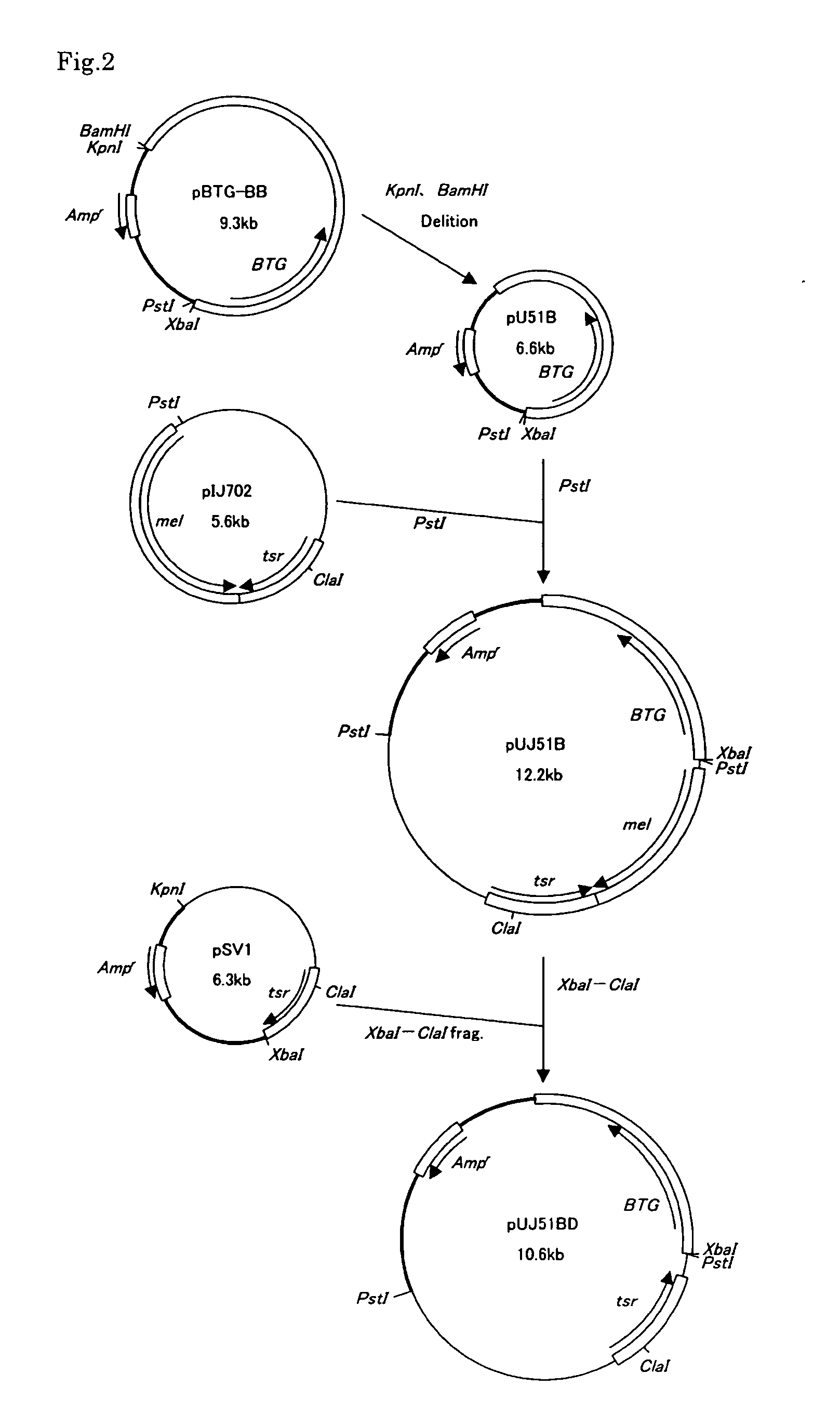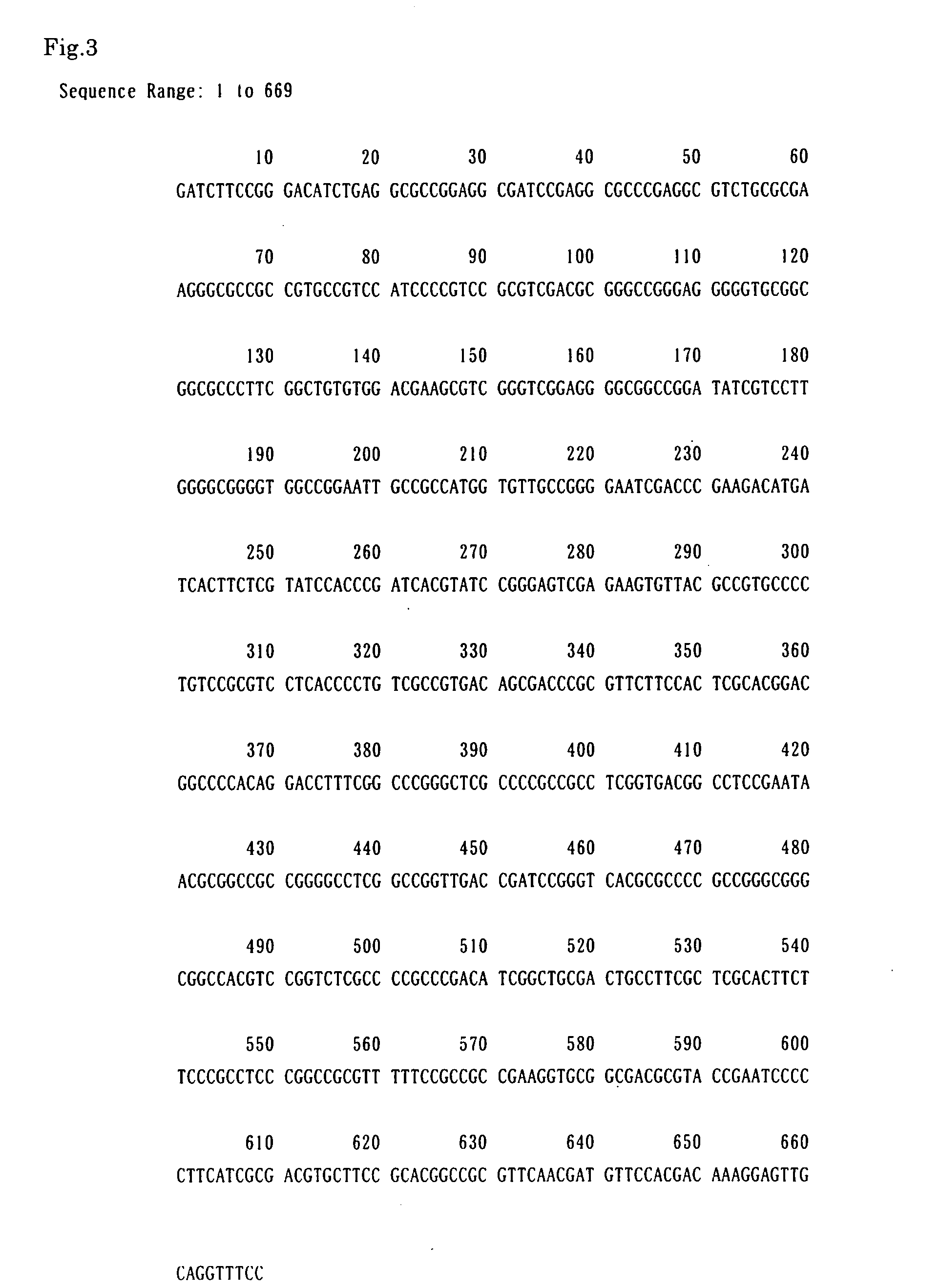Transglutaminase-producing strain
a transglutaminase and strain technology, applied in the field of transglutaminase-producing strains, can solve the problems and inability to say that sufficient productivity is obtained, and achieve the effect of low production yield, high production cost and sufficient productivity
- Summary
- Abstract
- Description
- Claims
- Application Information
AI Technical Summary
Benefits of technology
Problems solved by technology
Method used
Image
Examples
example 1
Obtaining Actinomycetes Vector pIJ702
[0071]Streptomyces lividans 3131 (ATCC 35287) containing a plasmid pIJ702 was cultured under the following medium conditions at 30° C. for two days.
YEME medium + 0.5% glycine + 50 μg / ml thiostreptonYeast extracts3gPeptone5gMalt extracts3gMagnesium chloride1gGlucose10gSaccharose340gGlycine5g50 mg / ml thiostrepton solution1ml / L (pH 7.0)(SIGMA: dimethylsulfoxide solution)
[0072] The 200 ml of cultured medium was centrifuged (12,000g at 4° C. for 10 minutes) and the obtained cell body was suspended in 10 ml of solution consisting of 50 mM Tris-HCl (pH 8.0), 10 mM EDTA and 25% Sucrose (hereinafter, referred to as “TE-Sucrose”). Then, 2 ml of TE-Sucrose containing 30 mg / ml of lysozyme (Sigma Aldrich Japan K.K.) and 4 ml of 0.25 mM EDTA were added to the suspension, which was incubated at 37° C. for 30 minutes. After incubation, 2 ml of 20% SDS was added, further 5 ml of 5M NaCl was added and gently stirred, and then incubated at 0° C. over night.
[007...
example 2
Obtaining Thiostrepton Sensitive Strain from Streptomyces lividans 3131 (ATCC 35287) Carrying pIJ702
[0074]Streptomyces lividans 3131 (ATCC 35287) containing pIJ702 was cultured at 30° C. for seven days using a YEME medium. Then, a culture solution was diluted to 105 to 109 times with the YEME medium. A 100 μl each of the diluted solution was inoculated on each of five plates containing a YEME agar medium (YEME medium supplemented with 1.5% agar). After culturing at 30° C. for a week, the cultured medium was replicated on the YEME agar medium containing 200 μg / ml of thiostrepton using RepliPlate™ Colony Transfer Pad (Takara Shuzo Co., Ltd.), and cultured again at 30° C. for a week. A strain, from which the plasmid pIJ702 was dropped to become a thiostrepton-sensitive strain, was selected to obtain Streptomyces lividans 3131-TS. This strain was used as a host for later transformation.
example 3
Obtaining Shuttle Vector pSV1
[0075] Shuttle vector pSV1 was constructed by the method shown in FIG. 1. First of all, a DNA fragment obtained by digesting E. coli vector pUC19 (Takara Shuzo Co., Ltd.) with a restriction enzyme Bam HI and a DNA fragment containing tsr obtained by digesting actinomycetes vector pIJ702 with Bcl I (Takara Shuzo Co., Ltd.) were prepared. These DNA fragments were ligated to each other by using DNA Ligation Kit (Takara Shuzo Co., Ltd.) to produce pUCTSR. Then, a DNA fragment (long fragment) obtained by digesting pUCTSR with Kpn I and Cla I (Takara Shuzo Co., Ltd.) and a DNA fragment (short fragment) obtained by digesting pIJ702 with Kpn I and Cla I (Takara Shuzo Co., Ltd.) were prepared, and these DNA fragments were ligated to each other by using DNA Ligation Kit (Takara Shuzo Co., Ltd.) to transform to an E. coli DH5 strain (TOYOBO Co., Ltd.). A plasmid was obtained by ligating pUC19 fragment and pIJ702 fragment which are carried by the thus obtained tran...
PUM
| Property | Measurement | Unit |
|---|---|---|
| pH | aaaaa | aaaaa |
| pH | aaaaa | aaaaa |
| pH | aaaaa | aaaaa |
Abstract
Description
Claims
Application Information
 Login to View More
Login to View More - R&D
- Intellectual Property
- Life Sciences
- Materials
- Tech Scout
- Unparalleled Data Quality
- Higher Quality Content
- 60% Fewer Hallucinations
Browse by: Latest US Patents, China's latest patents, Technical Efficacy Thesaurus, Application Domain, Technology Topic, Popular Technical Reports.
© 2025 PatSnap. All rights reserved.Legal|Privacy policy|Modern Slavery Act Transparency Statement|Sitemap|About US| Contact US: help@patsnap.com



